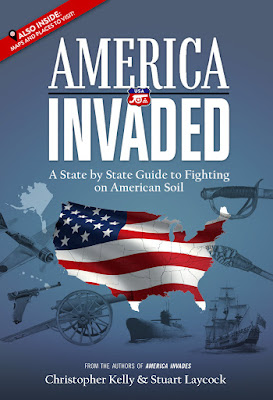 |
At the Patton Museum in
Chiriaco Summit, CA |
The General George Patton Museum (
http://generalpattonmuseum.com/), located in Chiriaco Summit, CA, was the site of the Desert Training Camp in World War II. From 1942 until 1944 about a million men and some women trained here for desert warfare. They lived in tents in the Mojave desert about 150 miles from Los Angeles. They trained for armored warfare over a desert that stretched over 18,000 square miles from Claremont CA to the Arizona border. Joshua Tree National Park, visited today by thousands of tourists, was once a tank proving ground.
General Patton, who grew up in Pasadena, CA, trained US armored forces here for desert combat prior to Operation Torch which targeted North Africa. The hard training in the California desert paid off when American forces arrived in North Africa in the fall of 1942. We wrote this in the Morocco chapter of
America Invades (
www.americainvades.com)...
 |
Commander Kelly w Sherman Tank
Patton Memorial Museum |
"On November 8, 1942, US troops, under the command of General George “Blood and Guts” Patton, who studied the Koran on the voyage across the Atlantic, landed on three sites on the coast.
The United States, in invading Morocco, was attacking a nation with which it was not at war at the time—Vichy France was technically neutral. The point of Operation Torch invasions across North Africa was to strategically outflank Rommel’s Africa Corps and the Italians in Libya who faced the British driving west from Egypt.
Despite hopes the Vichy troops would not put up much resistance, there were some fierce clashes. Nevertheless, compared to many later WWII operations in the Mediterranean, casualties were light, the fighting was brief, and the port city of Casablanca, a major target of Torch, eventually fell. About seventy-two hours’ worth of fighting was sufficient to satisfy the demands of French honor.
 |
Armored Vehicle
Patton Memorial Museum |
The classic movie
Casablanca was actually filmed in 1942 before the US capture of the city but had its world premiere in New York City on November 26, after it. If the timing of Torch had been different, so might movie history have been.
After the battle of Casablanca, the red carpet was rolled out for the surrendering French officers who had ruled Morocco. After negotiating the terms of surrender with the French, Patton, who was fluent in French, 'held up his hand and told them there was one last formality to be completed. 'Worried looks were quickly replaced by smiles as champagne bottles were opened and Patton offered a toast to the renewal of France and America’s age-old friendship." (Source:
www.americainvades.com)
 |
General Patton
USMA West Point, NY |
In the Tunisia chapter of
America Invades we noted...
"But by late 1942, it was we and the British who were about to invade it (Tunisia). Operation Torch was launched on November 8 with US and British landings in Vichy-French–controlled Morocco and Algeria in an attempt to attack Rommel’s Afrika Korps from behind. In response to these landings, however, the Germans rushed men and tanks into Tunisia to try to hold it against US and British forces advancing from the west, and our boys were in for something of shock.
In February of 1943, two veteran panzer divisions attacked the inexperienced American forces at Sdi-Bou-Zid and Kasserine Pass pushing rapidly forward against them. After the humiliation of Kasserine, British soldiers even brie y dismissed their American allies as being the Allied version of Italians, a reference to the commonly held belief among British troops that the Italians fighting against them were generally lower quality troops than the Germans also facing them.
However, this was soon to change. Eisenhower dismissed Lloyd Fredendall and put General George “Blood and Guts” Patton in command of II Corps in Tunisia. With fresh leadership, there was an almost immediate improvement in morale. On March 16, Patton told his staff, “
Gentlemen, tomorrow we attack. If we are not victorious, let no one come back alive.”
 |
Artillery
Patton Memorial Museum |
On April 3, Patton held a meeting in Gafsa with Air Marshal Sir Arthur Tedder to demand that his soldiers receive better air cover; they were interrupted by three Focke-Wulf fighters that strafed the streets and headquarters. Tedder, dusting himself off, inquired how the Germans had managed to achieve this, to which Patton famously replied, “
I’ll be damned if I know, but if I could find the sonsabitches who flew those planes, I’d mail each one a medal.”
 |
Patton Bust
Patton Memorial Museum |
With new leadership and growing experience, American performance rapidly improved. With vastly superior Allied numbers being brought to bear on the Axis forces, trapped and short of supplies in Tunisia, the battle there was going to end only one way. Von Arnim surrendered on May 12, 1943, and over 250,000 prisoners surrendered, about the same surrendered by Paulus’s Sixth Army at Stalingrad, though the victory at Stalingrad seems to have gotten better press over the decades and remains much better known today.
The Allies now had a secure platform from which they could invade Italy and drive Mussolini out of the war. Churchill commented in his memoirs that one continent had, at that point, been redeemed." (Source:
www.americainvades.com)
Visit the General Patton Memorial Museum (
http://generalpattonmuseum.com/) in the California desert and learn all about it!
For more on Patton see...
http://americanconservativeinlondon.blogspot.co.uk/2012/08/patton-quotes.html
http://americanconservativeinlondon.blogspot.co.uk/2017/03/invading-luxembourg.html
http://americanconservativeinlondon.blogspot.co.uk/2017/07/patton-in-pasadena.html
http://americanconservativeinlondon.blogspot.co.uk/2017/09/patton-invades.html
You can find signed copies of our books at
these web sites...
























